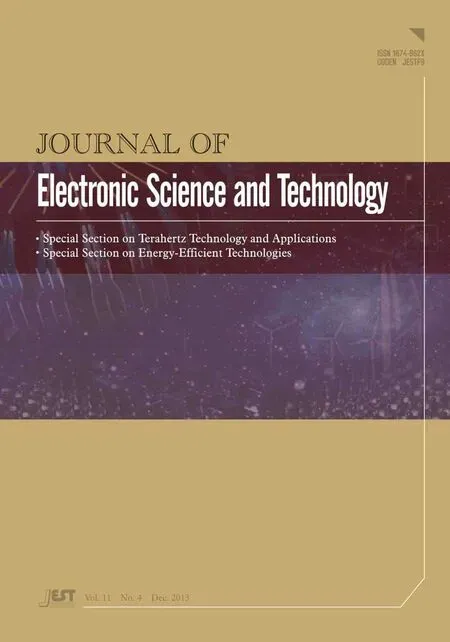Guest Editorial First Issue on the Special Section on Terahertz Technology and Applications
2013-02-19JamesKolodzey
James Kolodzey
During the past few years, the terahertz (THz)frequency regime has had renewed scientific and technological interest because of recent breakthroughs in the areas of high power sources, sensitive detectors, novel materials, and high resolution video imaging.Because it lies between the radio frequencies and infrared wavelengths,the terahertz electromagnetic region was thought to be promising for practical applications (300 micrometers wavelength corresponds to 1 THz frequency), but it suffered from very high attenuation through the atmosphere(above 1 dB/meter), and was found to be difficult to generate, modulate, and detect.On the other hand, many non-polar dielectric materials are transparent to THz waves,allowing the detection of inclusions, internal in homogeneities, or materials behind dielectric obstacles for see-through imaging.In addition, THz radiation has very low photon energies (4.1 meV per 1 THz) which is non-ionizing and safe for living tissue, and room temperature objects naturally emit at 30 THz, for example.1
As described in this first Special Section of the Journal of Electronic Science and Technology on the topic of Terahertz Technology and Applications, several new developments in sources, detectors, materials, and imaging techniques are now producing rapid growth in the THz field.These new developments will significantly benefit emerging applications in the fields of astronomy,communication systems, medicine, nondestructive testing,quality control, remote biochemical sensing, radar systems,security, spectroscopy, and stealth technology.
The objective of this first Special Section is to present research and development activities that are currently taking place in various aspects of terahertz science and technology by bringing together recent results on highly relevant topics.It is hoped that this Special Section will encourage scientists and engineers to become even more interested and involved in this promising and active research area.After a very careful review of many highly qualified submissions, the editorial committee accepted 5 papers for inclusion in this first Special Section.
The included papers are divided into general categories according to the different research topics concerning terahertz science and technology: high power sources;sensitive detectors; novel materials; and video imaging.
High performance THz systems require high power narrowband and tunable sources that operate at room temperature without cryogenic cooling.Prof.Peng-Xiang Liu and coworkers of Tianjin University describe monochromatic and tunable THz generation based on nonlinear optics.THz signals were produced by the methods of THz parametric oscillation (TPO) and by difference frequency generation (DFG) in materials such as the organic crystal DAST.
Low-loss, heterodyne terahertz detectors are needed for applications such as radar and communications.Prof.Bo Zhang and coworkers of the University of Electronic Science and Technology of China in Chengdu have demonstrated and simulated Schottky mixers that operate above 0.4 THz at room temperature as well as cryogenic temperatures, based on terahertz membrane integrated circuit (TMIC) technology.
Terahertz applications will require high performance components that are currently available for the optical,infrared, and microwave regions but not yet in the THz frequency regime.Prof.Yan Zhang and Mai-Xia Fu of the Capital Normal University in Beijing report on graphene, a one-atomic layer sheet of honeycomb carbon crystal that has unique carrier transport and optical properties.The terahertz properties of graphene are discussed, including recent trends for device applications.
Materials with high electromagnetic absorption are important for applications such as the reduction of interference, stealth technology, and the control of thermal emissions.At THz frequencies, however, there are few naturally occurring materials that have strong absorption coefficients but are also compatible with integrated circuit processing.Prof.Qi-Ye Wen and coworkers of the University of Electronic Science and Technology of China in Chengdu report on metamaterials that are resonant absorbers at THz frequencies.The metamaterials typically consist of three layers: an electric split-ring resonator, an insulating middle layer, and a metallic bottom layer.They analyze the metamaterial devices using a transmission line model, and demonstrate the operation of a broadband THz absorber.
With its short wavelength that gives higher resolution than using microwaves, and with its ability to penetrate various materials, THz imaging is receiving worldwide attention.It is challenging, however, to build a system that operates at room temperature, has high resolution, and can produce images at standard video frame rates.Prof.Min Hu and coworkers of the University of Electronic Science and Technology of China in Chengdu report on the performance of two types of imaging systems that produce two-dimensional scans of an object, using a THz gas laser for illumination.One system uses a pyroelectric sensor containing a 124×124 pixel array, and the other system uses a single Golay cell detector where the object is mechanically raster scanned.
On behalf of the editorial committee, we express our sincere thanks to all authors and reviewers for their great contribution to this first Special Section.Also, we thank the editorial committee members for their excellent assistance.Finally, we are grateful to the editorial staff for their help.Without all of the contributions of these hard-working,dedicated people, it would have been impossible to produce this first special issue.
杂志排行
Journal of Electronic Science and Technology的其它文章
- FPGA-Based Network Traffic Security: Design and Implementation Using C5.0 Decision Tree Classifier
- Characterization of Fundamental Logics for the Sub-Threshold Digital Design
- Saudi License Plate Recognition Algorithm Based on Support Vector Machine
- Mobile Web Middleware of NFC Context-Awareness Applications
- Metamaterial Absorbers in Terahertz Band
- Analysis of the Signal of Singing Using the Vibrato Parameter in the Context of Choir Singers
